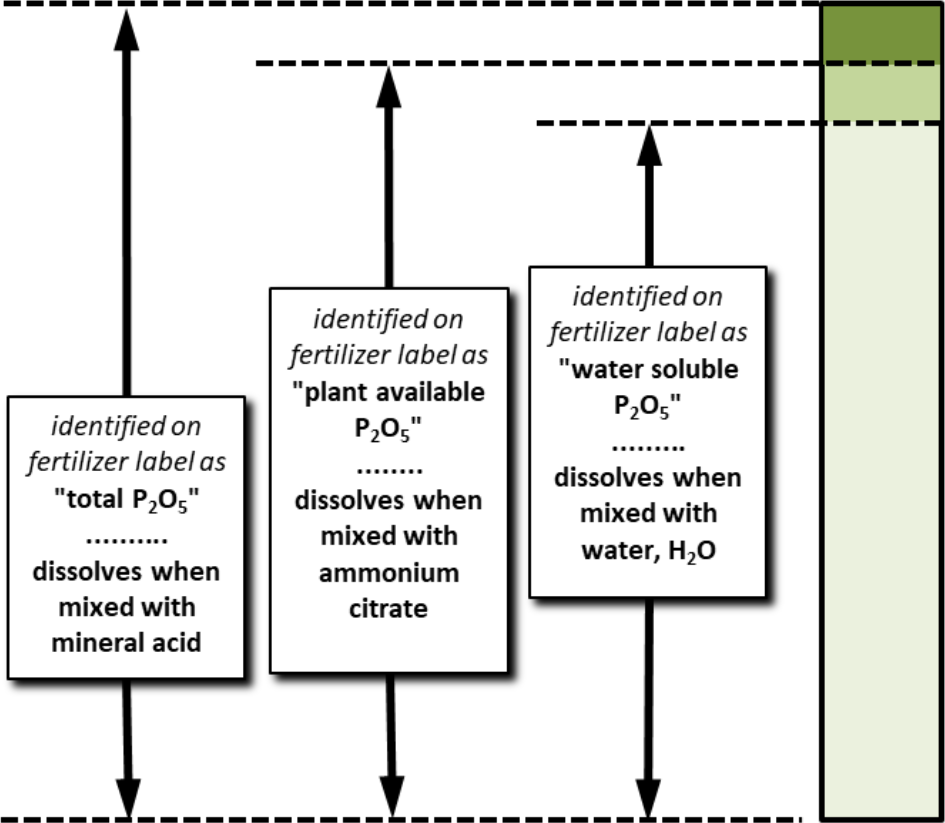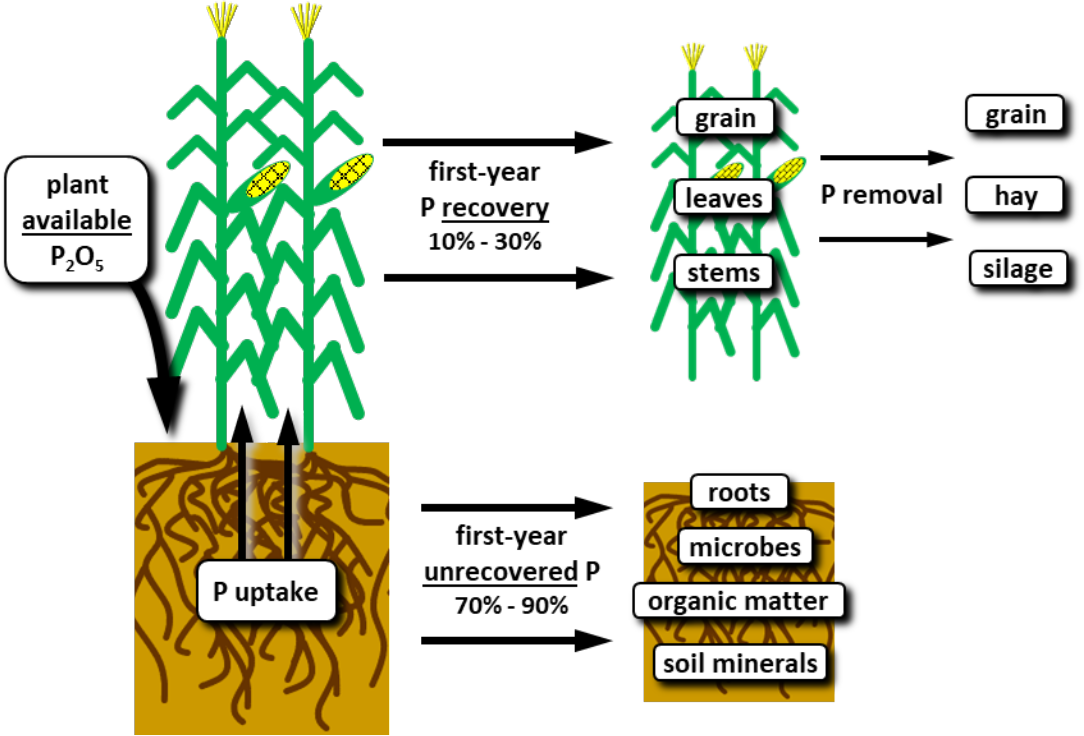⇦ Back to Fertilizer Lime Amendment Technology and Use Home
¶ Introduction
People use, confuse, and often misuse the various terms associated with phosphate fertilizer materials and usage. This Crop File defines and discusses some of these terms.
¶ A. Phosphorus (P)
- Elemental phosphorus
- Chemical element of atomic number 15
- Poisonous, combustible nonmetal
- Exists in two common forms
- White phosphorus: yellowish waxy solid
- Ignites spontaneously when exposed to air
- Glows in the dark
- Red phosphorus
- Less reactive form
- Used in making matches
- White phosphorus: yellowish waxy solid
- Essential component of living systems
- Found in nervous tissue, bones and cell protoplasm
- All energy production and storage are dependent on phosphorus compounds
- e.g., adenosine triphosphate (ATP)
¶ B. Phosphate (PO43+)
- Is expression for ionic form of phosphorus
- Ion: atom or molecule with net electric charge due to loss or gain of one or more electrons
- Also referred to as “orthophosphate”
- Concentration in liquid solution is often expressed as “phosphate-phosphorus” or PO4-P”
¶ C. Phosphate (P2O5)
- Expression used for phosphorus concentration as “percent phosphorus penta-oxide” or “% P2O5”
- Expression used with fertilizers, but not soils or water
- Recommendations and rates for agronomic phosphorus use commonly expressed in format as “pounds of phosphate per acre” or “lb P2O5/ac”
- Phosphorus not actually present as P2O5
- P2O5 is older “oxide” method of chemical expression used in late 1800’s and carried over into modern industry
- P2O5 is equivalent value required by most state fertilizer regulations, where: % P2O5 = % P * 2.29
¶ D. Water-soluble Phosphorus
- Percentage of total fertilizer phosphate (expressed as % P2O5) that has dissolved readily in water
- Most commercial phosphate fertilizers are 90% to 100% water soluble
- Fertilizer sample is mixed in deionized water
- Filtered to remove undissolved material
- Analyzed to determine amount of phosphorus in liquid filtrate
- Expressed as “water-soluble % P2O5”
¶ Figure 1. Phosphare Fertilizer Fractions

¶ E. Citrate-soluble Phosphorus
- Solid fertilizer material that does not dissolve in water and remains in filter Is mixed into ammonium citrate solution (C6H17N3O7)
- Liquid filtrate is analyzed to determine amount of solid that was dissolved by ammonium citrate solution
- Expressed as “citrate-soluble % P2O5”
¶ F. Citrate-insoluble Phosphorus
- Amount of phosphorus that does not dissolve in either water or ammonium citrate
- Expressed as “citrate-insoluble % P2O5”
¶ G. Total Phosphorus
- Is sum of water-soluble, citrate-soluble, and citrate-insoluble phosphorus
- Fertilizer sample is treated with mineral acid (often nitric acid) to digest entire sample
- Acid digest is analyzed to determine phosphorus concentration
¶ H. “Plant Available” Phosphorus
- Sum of water-soluble phosphorus plus citrate-soluble phosphorus expressed as “% P2O5”
- Citrate-soluble P2O5 fraction is usually less than water-soluble P2O5.Amount of phosphorus guaranteed on fertilizer label
- Is legally considered “plant available” phosphorus
- Example: product with guaranteed analysis on label listing “Available Phosphate … 46.0% P2O5”
- Sample was dissolved in water, then in ammonium citrate
- 20% of sample determined in laboratory to be water-soluble plus citrate-soluble phosphorus (P), but is expressed on label as 46% phosphate (P2O5)
- 46 lb. of 100 lb. of bulk fertilizer material considered phosphate (as P2O5) that is “chemically available” to plant
¶ I. Phosphorus Availability
- “Chemical” availability and “positional” availability can be different
- “Chemical” availability refers to phosphorus content as guaranteed on product label as required by regulatory agency
- Agronomic availability to plants may be influenced by certain soil conditions (e.g., soil pH, presence of aluminum or calcium, etc.) that affect solubility of phosphorus compounds that may be subsequently formed after soil application
- Some materials may be “positionally unavailable” to plants
- Can be chemically available, but may not be placed for plant uptake
- If placed where roots cannot intercept fertilizer material or if soil condition prevents roots from intercepting fertilizer material (e.g., soil compaction)
¶ J. Phosphorus “Recovery”
- Recovery can be defined several ways
- Commonly determined using “difference” method
- Recovery = (Fertilized - Unfertilized) / Applied
- Is amount of phosphorus found in the stems, leaves, grain, etc. of fertilized crop minus amount found in stems, leaves, grain, etc. in unfertilized crop, divided by amount of phosphorus applied before planting
- This value frequently considered to be “apparent recovery” or “apparent efficiency” of applied phosphorus
- Common for about 10% to 30% of applied phosphorus to be recovered by crop during first year following application
- Remaining portion of phosphorus is unrecovered after first year
- Typically contained in root tissue and is utilized by soil microbes
- Unrecovered phosphorus contributes to soil phosphorus reserves, both mineral and organic
- Unrecovered phosphorus s responsible for building soil test phosphorus
¶ Figure 2. Phosphorus “Availability” Terminology

¶ K. Phosphorus “Uptake”
- Amount of phosphorus extracted by plants from soil, regardless of source
- Mix of native soil phosphorus and applied phosphate fertilizer
- Includes phosphorus found in both harvested and unharvested above-ground biomass
- Includes the stems, leaves, grain, fruit, etc
- Does not include phosphorus found in the roots
¶ L. Phosphorus “Removal”
- Amount of phosphorus contained only in harvested portion of the crop
- Does not include phosphorus content of stems or foliage if crop is harvested as grain or fiber
- Does include phosphorus in stems and foliage if crop is harvested as forage (hay, grain, or grazing)
- Uptake may be different than removal, depending on whether it was harvested as grain or as forage
- Example:
- Corn harvested as grain typically removes about 0.31 lb of P2O5 per bushel of grain (at 14.3% moisture)
- Corn harvested as whole-plant silage typically removes about 3.4 lb P2O5 per ton (at 66% moisture)
- Example:
¶ References
Syers, J.K. et.al. 2008. Efficiency of soil and ferilizer phosphorus use. Fertilizer and Plant Nutrition Bulletin #18. U.N. Food & Agriculture Organization. Rome.
Rehm, G. 2013. Nutrient availability is not the same as nutrient uptake. AgBuzz, Univ. of Minnesota Extension. George Rehm on 06 Jun 2013\\